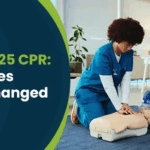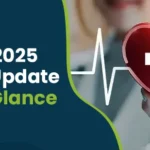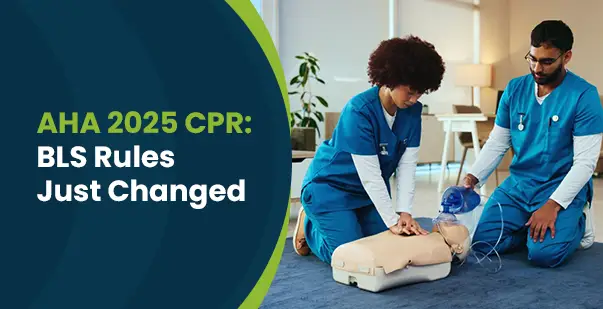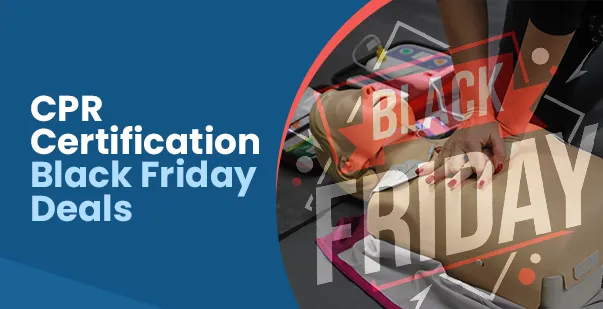More than 436,000 people lose their lives to cardiac arrest each year in the US alone, underlining the need for cardiopulmonary resuscitation (CPR). It is a life-saving skill that helps keep blood and oxygen flowing to the brain and heart when someone’s heart has stopped.
In this blog, we talk more about CPR training, answering common questions and doubts most enrollers have, from duration to topics covered.
Duration of CPR Classes
A CPR class teaches people how to perform CPR effectively in different emergency situations. The duration of CPR classes can vary depending on the level of training and the specific skills being taught. Here’s what it involves:
1. Standard CPR Classes
Standard CPR classes are for anyone who wants to learn the basics of CPR. They teach how to do chest compressions and rescue breaths. These classes usually last 2 to 4 hours.
They’re good for people who want to know how to help in an emergency but don’t need a lot of detailed training.
So, if you want to learn CPR without spending too much time, a standard CPR class is a good option.
2. Certification Courses
Certification courses offer more detailed training in CPR along with topics like first aid and using AEDs. These courses are for people who want official certification, like for a job requirement or personal satisfaction. They typically last longer, usually around 4 to 8 hours, to cover everything thoroughly.
Certification ensures that participants have the necessary skills and knowledge to perform CPR confidently in real-life situations.
These courses provide a deeper understanding of CPR techniques, making participants better prepared to respond to emergencies and potentially save lives.
3. Advanced CPR Classes
Advanced CPR classes are for people like doctors or paramedics who need to learn more about CPR. These classes are longer, usually taking 8 to 16 hours. They teach advanced ways to help in different medical emergencies.
They cover tricky situations and how to handle them well. For example, they might learn how to use special equipment or work together in teams during emergencies.
These classes are super important for pros who deal with tough situations a lot. They make sure these pros have the best skills to save lives when people need help the most.
4. Healthcare Provider CPR Courses
Healthcare Provider CPR Courses are for doctors, nurses, and other medical workers. They teach CPR skills for hospitals or clinics.
These classes cover advanced techniques, checking patients, and working in teams. They’re longer, usually taking 16 to 20 hours, because they go into more detail about medical stuff and safety.
Doctors and nurses need this extra training to handle emergencies well and help patients. So, if you’re a doctor or nurse, taking this course is really important for being ready to help in your workplace.
Factors Influencing Class Duration
In most cases, regular CPR classes take about three to four hours. But when you say “How long is a CPR class”, it can change based on what kind of certification you want, what the class covers, and how fast the teacher goes.
Let’s take a look at what can make CPR classes shorter or longer:
1. Curriculum Complexity
The complexity of what’s being taught affects how long a CPR class lasts. Basic classes, with just the essentials of CPR, tend to be shorter.
But if the class covers more advanced topics, like using an AED or First Aid, it’ll take longer. So, think of it like this: the more things you need to learn, the more time it’ll take to teach them. If you’re just starting out with CPR, you might be in and out of class pretty quickly.
But if you’re diving into all the ins and outs, expect to spend more time in the classroom.
2. Class Format
The format of a CPR class (whether in-person, online, or blended) affects how long it takes. In-person classes often run 3–4 hours since they include hands-on practice, real-time feedback, and short breaks to keep participants fresh and focused.
Online courses, which you complete at your own pace, typically take 1–2 hours but may lack real-world application.
Blended courses combine both formats, offering around 1–2 hours online and 1–2 hours of in-person skill sessions.
According to a study, over 70% of participants preferred blended learning for its balance of flexibility and hands-on experience.
3. Skill Level of Participants
The skill level of participants influences the length of a CPR class because people learn at different speeds. If the class includes both beginners and experienced individuals, the instructor may need to spend more time on basic concepts to ensure everyone understands.
For example, beginners might need extra practice and explanation, while those with some experience might move through the material more quickly.
This means that a class with varied skill levels can take longer to complete compared to a class where everyone has the same level of knowledge and experience with CPR.
4. Class Size
The number of people in a CPR class can change how long it takes. In a smaller class, each person gets more one-on-one time with the instructor, so you can learn and practice faster.
With a larger group, the instructor needs to make sure everyone gets enough practice and understands the material, which takes more time. Imagine trying to learn something new: in a big crowd, you might have to wait your turn more, which makes the whole class longer.
So, more students often mean the class lasts longer because everyone needs enough practice and attention.
5. Demonstration and Practice Time
CPR isn’t something you can just learn by watching, you need to get hands-on. That’s why instructors spend time demonstrating techniques like chest compressions and rescue breaths on a manikin. After that, it’s your turn to practice.
Hands-on practice also adds to class time, depending on how many participants are practicing on manikins and how many techniques are being covered.
Some learners might need more rounds of repetition to build confidence, which can extend the session.
The goal is to make sure everyone leaves class feeling ready—not rushed.
6. Accessibility of Training Equipment
The availability of training equipment, such as manikins and AED trainers, influences the duration of CPR classes. If there are enough manikins and AEDs for everyone, students can practice skills simultaneously, making the class more efficient.
However, if equipment is limited, students must take turns, leading to longer practice times and extended classes. Having adequate training tools ensures each participant gets hands-on experience without waiting, speeding up the learning process.
Thus, classes with well-equipped training setups tend to be shorter, while those with fewer resources might take longer due to the need for sharing and rotating equipment.
7. Breaks and Refreshment Periods
Breaks and refreshment periods can lengthen a CPR class. These pauses give participants time to rest, absorb information, and stay engaged, especially in longer or more intensive sessions.
Classes lasting several hours or more usually include scheduled breaks for snacks, meals, or just stretching. This downtime helps prevent fatigue, keeping everyone focused and ready to learn. Though essential for maintaining energy and concentration, these breaks add to the total time needed for the class.
So, the need for breaks means the class isn’t just about teaching and practicing CPR—it also includes time to recharge.
Be Prepared. Be CPR Certified.
Start your online CPR training today and learn life-saving skills.
What Does CPR Training Cover in Those Hours?
CPR training covers a wide range of topics to prepare individuals to respond effectively in emergency situations. Here’s what you can expect to learn during a CPR training course:
- Understanding CPR: You’ll learn what CPR is, why it’s important, and when it should be performed.
- Basic Life Support (BLS): This includes learning how to perform high-quality chest compressions, deliver appropriate ventilations, and provide early use of an AED.
- Advanced Cardiovascular Life Support (ACLS): This is more advanced training, often required for healthcare providers and first responders.
- Pediatric Advanced Life Support (PALS): This training focuses on the specific needs and challenges of pediatric patients.
- First Aid and AED Training: You’ll learn how to use an Automated External Defibrillator (AED) and basic first aid techniques.
- Heartsaver Courses: These courses are designed for anyone with little or no medical training who needs a course completion card for job, regulatory (e.g., OSHA), or other requirements.
- Training for Specific Populations: Some courses focus on providing care for specific populations, such as children or the elderly.
- Hands-On Practice: Most courses include hands-on practice to help you feel confident in your ability to perform these life-saving procedures.
Remember, the specific curriculum may vary depending on the organization providing the training and the level of the course (basic vs. advanced).
Do Online CPR Classes Take as Long as In-Person Ones?
The first question busy professionals ask is – how much time does it take to complete CPR training? The answer really depends on whether you choose to learn online or attend an in-person training session.
Online CPR courses offer the advantage of flexibility, allowing learners to complete the training at their own pace. On average, an online CPR course can be completed in one to two hours. This is because online courses are designed to be self-paced, and learners can access the course materials anytime and anywhere.
In-person CPR training on the other hand follows a fixed schedule, typically spanning a single day or several hours over multiple days. This is due to the hands-on nature of the training, which often involves practical demonstrations and direct feedback from instructors.
The choice between the two often depends on individual learning preferences and requirements.
Breakdown by Course Type
Whether you’re a parent looking for basic CPR or a healthcare worker renewing your BLS, each path comes with its own timeline.
To help you decide quickly, here’s a snapshot of how the major CPR classes stack up.
Let’s break it down.
|
Course Type |
Online Learning |
Hands-On Practice |
Total Duration |
Good For |
|
Basic CPR (Public) |
1–2 hours |
1–2 hours |
3–4 hours |
Parents, Teachers, Fitness Trainers |
|
BLS (Healthcare) |
1–2 hours |
2–2.5 hours |
~4.5 hours |
Nurses, EMTs, Doctors |
|
ACLS (Advanced) |
Not typically online |
12–16 hours |
12–16 hours |
ICU, ER, Advanced Medical Staff |
|
PALS (Pediatric) |
Not typically online |
14–16 hours |
14–16 hours |
Pediatricians, NICU Nurses |
Who Needs CPR Classes?
CPR is a basic life-saving skill useful for resuscitating someone who is choking, drowning, or having a sudden cardiac arrest. Acting quickly with CPR or Advanced Cardiovascular Life Support (ACLS) can be the difference between life and death. The faster CPR starts, the better the chance of survival.
Anyone can learn CPR, though certification usually requires you to be at least 16 years old.
Certain jobs require CPR certification, including:
- Healthcare workers
- Fitness trainers
- Teachers and childcare workers
- Lifeguards
- Volunteers and community members
- Sports coaches
Additionally, most U.S. states require high school students to take a CPR class to graduate.
How Much Does a CPR Class Cost in the U.S.?
The cost of a CPR class in the U.S. usually ranges from $40 to $120, depending on the type of course, the format (online or in-person), and whether it includes certification. Basic CPR courses for the general public, costs around $50 to $70.
Whereas, Basic Life Support (BLS) class typically ranges between $70 and $100, especially if it includes hands-on skill testing.
Advanced courses like Advanced Cardiac Life Support (ACLS) or Pediatric Advanced Life Support (PALS) can go up to $150 or more due to the longer training time and complexity.
Also, keep in mind that prices may include printed materials or digital access, and some places charge extra for official certification cards, so always check what’s included before you sign up.
Learn CPR. Save Lives. Get Certified Online.
Master essential CPR techniques and get certified today.
Ready to Save a Life? Take the First Step with CPR Training
Knowing how long a CPR class takes is important for planning, but what truly matters is the impact it can have on saving lives. CPR training equips ordinary people with the skills to respond confidently and effectively in emergencies. By investing just a few hours in learning CPR, you can become a crucial link in the chain of survival, potentially saving the life of a loved one, a friend, or even a stranger. So, take the time to learn CPR—it’s a small commitment with the potential for enormous impact. Be prepared, be empowered, and be a hero when it matters most.
Frequently Asked Questions (FAQs)
Online vs In‑Person: Which is Faster?
Online CPR classes are usually faster because you can finish them at your own speed, sometimes in just 1–2 hours. In-person classes take longer (around 2 to 4 hours) since they include live teaching and practice with an instructor.
Can You Get CPR Certified in Under 1 Hour?
Yes, some online-only courses let you complete the lessons and quiz in less than an hour. But to get fully certified for work or official use, you’ll still need to do hands-on practice, which takes extra time.
How Long Does CPR Certification Last?
Most CPR certifications stay valid for 2 years. After that, you’ll need to take a short cpr renewal class to keep your skills fresh and stay certified.
Is passing a CPR class hard?
No, it is beginner-friendly, and straightforward with practice and attention.
How long does CPR take on average?
A CPR class usually takes 2 to 4 hours.
Is the CPR test an open book?
Often yes, especially for online or blended courses.
How many questions are on a CPR test?
Usually around 20 to 30 questions.









